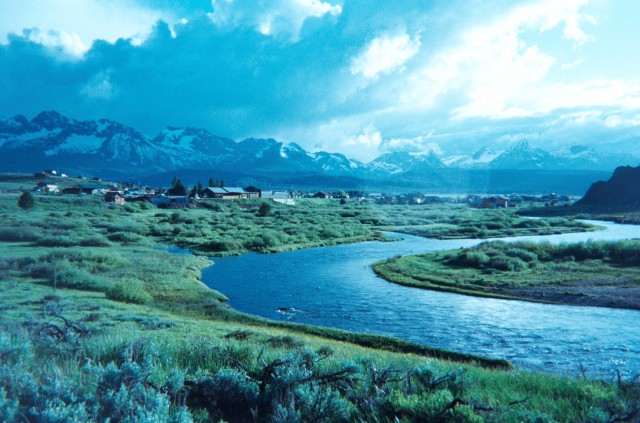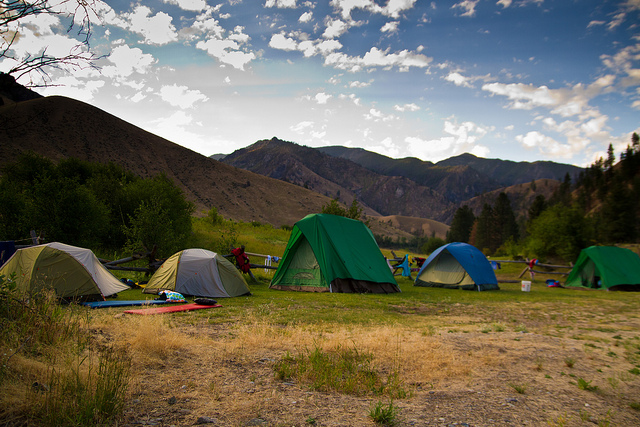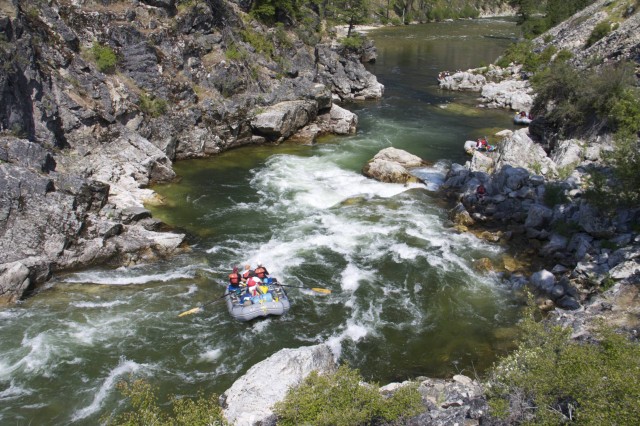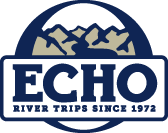Middle Fork Rafting With ECHO
In the early season, when the river is high, we begin our trip with a two hour bus drive from Stanley to Boundary Creek, the end of a dirt road and the beginning of the wilderness. Boundary Creek is 5700 feet in elevation and the river is really a fast creek. For most of the season we fly from Stanley into Indian Creek, 25 miles downstream. The spectacular 30 minute flight into the Forest Service airstrip is ample compensation for the section of river that we miss, and the remaining 75 miles give us everything the Middle Fork is known for.

Stanley, Idaho and the Middle Fork of the Salmon River
The Middle Fork can be viewed as three distinct rivers in three distinct canyons. When we begin, the river is small and fast. The canyon is intimate, and we float past dense groves of lodgepole pine and Douglas Fir.
We cover fewer river miles the first couple of days, but we stop at some wonderful hot springs and arrive in camp tired but with a satisfying sense of a good day's travel. The nights are cool, and we are drawn to the campfire for warmth as well as light and good company. We set a routine of breakfast around 8:00 AM, followed by packing up, loading the rafts and hitting the river around 10:00 AM. We float for about three hours, then take an hour or so break for lunch. We float for another few hours before stopping to camp for the night.
In the second section the canyon opens up. The nights are warmer, the vistas broader, and the campsites larger. Walking is easier, and a short hike uphill always reveals views of the river and camp worth several photographs.

Camping along the Middle Fork of the Salmon River
As we pass Big Creek we enter Impassable Canyon. Here the river has cut its way through the Big Horn Crags, one of the most rugged mountain ranges in the nation. The camps in Impassable Canyon are a bit smaller than what we have become used to, since there is simply not much room down there.
The views are incredible as we watch the colors and shades of the cliffs. The real world lurks downstream and our group, drawn close from the shared excitement, beauty, and campfire conversation savors the last evening.
"If I had to choose one river to run, once a year for the rest of my life, the choice would be easy. I would choose the Middle Fork."
- Jeff Rennicke, river guide and writer
Sometimes the night becomes a party with make-shift costumes and even skits. Other times it is a subdued occasion, as folks choose to talk quietly and reflectively about the trip and the place it will hold in their memories.
We arrive at the take-out just beyond the confluence with the Middle Fork and Main Salmon. Here we enjoy a nice afternoon lunch before we our journey back into the front country.
After a good shower and a bit of rest, we often have a farewell dinner (or our first trip reunion) at the Shady Nook, a pleasant restaurant a short walk from our hotel rooms.
Whitewater
The Middle Salmon begins small and fast. There are few major rapids (but watch out for Velvet Falls), yet the countless minor ones demand our attention. Gradually the canyon opens up. The river is now a real river, broad and sometimes shallow, sometimes constricted into narrow slots of rushing water, waves, and holes. We will be challenged by Marble Rapid, Grouse, and the Tappans. In the Middle days of our trip the water is slower but great fun, especially for those in duckies.

Pistol Creek Rapid on the Middle Fork
When we enter Impassable Canyon the river becomes so tight that, looking downstream, one sometimes doubts there will be room for the rafts. Here the rapids are larger, more exciting, and more frequent. Redside, Porcupine, Cliffside, and Weber come in quick succession, and are followed shortly by Rubber, the largest rapid on the river. Soon after Rubber the rapids House Rock, Hancock, Devil's Tooth, and others follow in quick succession. We end the trip with a few miles of big roller coaster waves on the Main Salmon.
Natural History
Wildlife in the Middle Fork canyon includes deer, elk, bear, cougar, coyote, fox, river otter, Bighorn Sheep, and mountain goat. Most wildlife will make an effort to stay out of view, but the Bighorn Sheep are amazingly unafraid of river travelers. Small herds of ewes and kids will often stand a few feet off the water and watch boats float by. Ram and bear sightings are becoming more common and eagles soar overhead.
When we begin the river is small and fast, the canyon tight and intimate, and we float past dense groves of Lodge pole Pine and Douglas Fir. Gradually the canyon grows and opens up as the Lodgepole Pine forest is replaced by grass, sagebrush, and the occasional but majestic Ponderosa Pine. This is the winter home of the elk, who have headed for the high country by the time we arrive. As we enter the famous Impassable Canyon, spectacular sheer rock walls replace the more gradual slopes, and the canyon narrows in dramatic beauty.
Superb Fishing
The Middle Fork is a superb fishing stream, and is one of the few native fisheries left in the United States. This means that it has never been stocked with hatchery fish. The abundant Dolly Varden, Cutthroat Trout, Rainbow Trout, Steelhead, and endangered Chinook Salmon are all native fish protected by a catch and release law. Fishermen must use barbless hooks and release their fish unharmed. The water is so clear that it is common to spot countless fish from boats.
How is the Food?
We provide three hearty meals a day, from lunch on the first day to lunch on the last day. We specialize in creative, delicious, and healthy food: the product of over three decades of developing menus. Your guides prepare and clean up all of the meals. Vegetarian and medically restricted diets will gladly be accommodated: just tell us in advance.
What is Included in the Middle Fork Trip Cost?
|
|
What Am I Responsible For?
|
|
